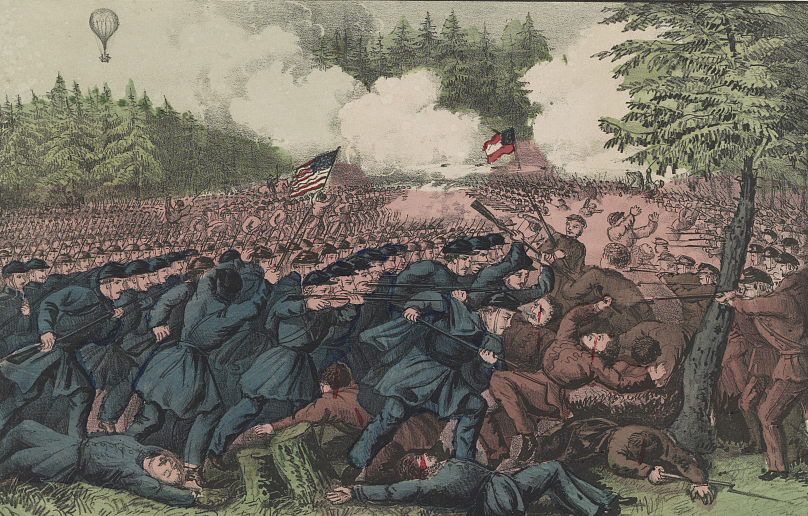
balloons were used to gather military intelligence during the Civil War
Source: Library of Congress, The Battle of Fair Oaks, Va. May 31st, 1862

balloons were used to gather military intelligence during the Civil War
Source: Library of Congress, The Battle of Fair Oaks, Va. May 31st, 1862
Ballooning began in France, with the first hot air balloon flight carrying a person in 1783. Thomas Jefferson brought back descriptions of the new technology, and by 1786 the Balloon Club at the College of William and Mary was constructing hot air balloons.1
Joseph Shelton Watson wrote his brother in 1801 that the first attempt failed:2
Watson and other students, organized as the Balloon Company, persisted. Their third attempt was successful, and launched an unmanned balloon:3
Gathering military intelligence from balloons was started by the French in 1794. In North America, ballooning was primarily done by carnival performers until the start of the Civil War.
John La Mountain, famed for two long-distance flights in 1859, proposed at the start of the Civil War that the Union Army also use balloons to carry dispatches and drop bombs. Those were not new ideas. During the siege of Vera Cruz in 1847, John Wise (known later as the "Father of American Aeronautics") proposed using a balloon to drop 18,000 pounds of explosives. In 1859 Wise delivered the first Postal Service air mail via balloon.
John Wise filled a balloon at the Washington gas works in June, 1861 and had it towed across the Potomac River to the Arlington House. It was then pulled to Falls Church and used to scout the Confederates at Fairfax Courthouse. That ascension is the first military use of aerial reconnaissance in the United States.
Several failed attempts by the Union Army to launch a balloon from Alexandria County in July, 1861, were followed by a successful reconnaissance on July 25. That allowed the Union Army to determine they were not threatened by a Confederate attack after the Battle of First Manassas. John Wise supposedly fired a rifle at Confederates from the balloon that day, so the first aerial attack occurred in Northern Virginia.
Both the Confederate and Union sides used balloons. A Confederate artillery officer went up multiple times during the 1862 Seven Days Campaign outside Richmond. Counting the number of tents, or campfires at night, provided a guide to the strength of the opposing force. Confederate General P. G. T. Beauregard responded by having his troops pitch tents in areas covered with trees, and to conceal campfires at night.
With clear support from President Lincoln, a civilian Balloon Corps was established on the Union side. Because that side had more balloons and because photographers had greater access to the Union side, the only photographs of balloon use in the Civil War are from that side of the conflict. Many pictures include the gas generating wagons where sulfuric acid was mixed with iron filings to generate hydrogen. That allowed the Union side to have more mobility for its Balloon Corps.
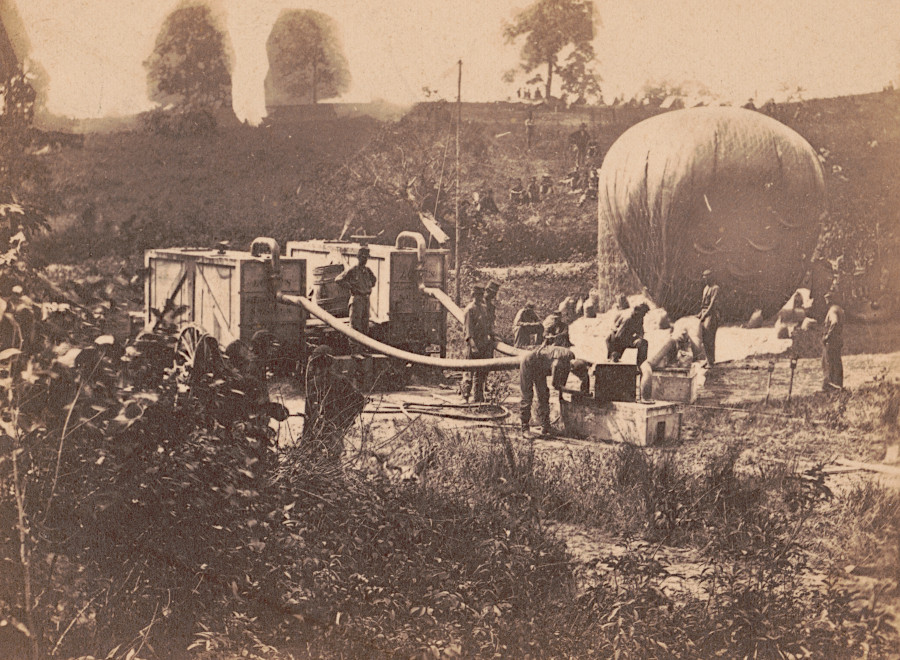
in the Union Army, portable gas generation wagons mixed dilute sulfuric acid and iron filings to generate hydrogen during the Civil War
Source: Library of Congress, Professor Lowe inflating Balloon Intrepid to reconnoiter Battle of Fair Oaks
In Richmond, the Confederates used methane from the gas works to inflate balloons and then pull them to the front lines. The Silk Dress Balloon, made in Savannah from multicolored length of silk intended for making dresses, was moved by railroad from the city gas works to the observation site. At Yorktown, Confederates used burning pine knots soaked in turpentine to generate gas needed for one ascension.
The first flight from a ship, creating the first aircraft carrier, occurred at Fort Monroe. John La Mountain was in the tethered balloon when it lifted off from the gunboat Fanny on August 3, 1861.
The coal barge George Washington Parke Custis was converted to be a balloon transport and launch vessel. One of the 12 portable hydrogen generators designed by Thaddeus Lowe, the head of the Balloon Corps, was placed on the vessel to inflate balloons as needed. A tug was used to move the George Washington Parke Custis around; the barge itself had no steam engine. Confederates used the CSS Teaser to transport a balloon on the James River.
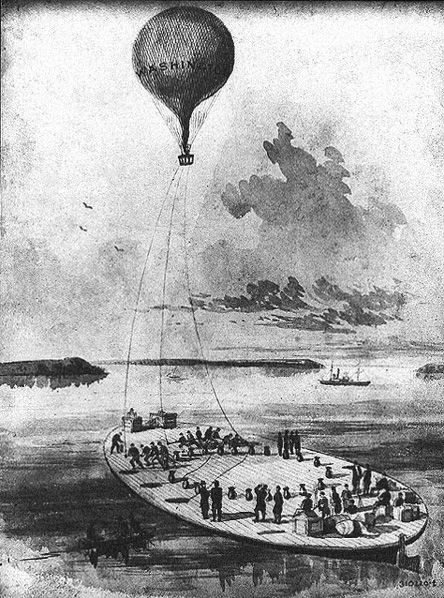
during the Civil War, Union forces modified a coal barge to serve as a mobile platform for launching balloons
Source: Wikipedia, USS George Washington Parke Custis (1861)
Balloons floated 500-1,000 feet high to scout enemy forces within a 15-50 mile radius. The largest balloons in the Union Army could carry five people, and information was transmitted from a telegrapher in the balloon back to the ground via a wire alongside the tether. Though photographers has made pictures from balloons prior to 1861, no aerial photographs were taken during the Civil War. Military officers apparently were satisfied by information from the balloons communicated via telegraph, sketches and words.
During the Civil War, cannons and rifles fired at balloons but none were shot down. Balloons were tethered to allow the safe retrieval of the occupants, but occasionally got loose and created unplanned high-risk flights. At least seven times, John La Mountain flew untethered around Alexandria.
The Balloon Corps was never incorporated into the Union Army. It was a civilian operation, and military officials found it difficult to work with the civilians. Union balloonists noted the first movements of Confederate troops towards Gettysburg in the summer of 1863, but around that time the Union Army stopped supporting the Balloon Corps and flights ended. The Confederate artillery officer who had ascended several times in 1862 commented after the war:4
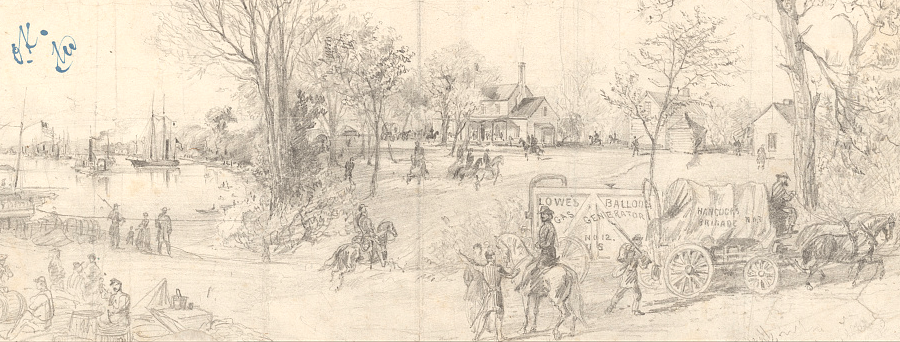
during the Civil War, balloons were transported by ship/wagon and then inflated where launched with gas generators
Source: Library of Congress, The Curtis Estate, the scene of Washington's courtship & etc etc, Pamunkey River, near R.R. to Richmond
During World War I, General Pershing created the Air Service, moving heavier-than-air and lighter-than-air operations out of the Signal Corps. Some planes were used to bomb munition dumps and transportation infrastructure, but most aircraft and all balloons were used at the front lines to provide information about targets for artillery and troop movements on the ground. In the days before effective radio, pilots transmitted data via visual signals and dropped messages.5
The United States used balloons in Europe just for observation, and provided parachutes to observers in case a German plane attacked. Other nations fighting in Europe deployed barrage balloons for defense, to block enemy aircraft from low-level strafing and bombing.
In the 1920's, the United States Air Service within the US Army and the Coast Artillery Corps feuded over who had responsibility for developing and operating barrage balloons. The Coast Artillery Corps was responsible for ground-based antiaircraft defense, and ended up with the responsibility for deploying balloons which the Air Service developed in Dayton, Ohio. In 1926, the Air Service was renamed the Air Corps.
Three barrage balloons were shipped from Dayton to Fort Monroe for testing by the Coast Guard Artillery in 1927. The testing was shifted quickly to Langley Field, where it was easier to generate hydrogen. One balloon escaped and one was destroyed in two years of testing, and the program at Langley Field ended.
In 1938, the Air Corps restarted testing barrage balloons in Oklahoma. After the military ordered 4,400 barrage balloons in 1940, it discovered there was not enough helium for them so hydrogen was used instead.6
The National Aeronautics and Space Administration (NASA) has based its Balloon Program Office at Wallops Flight Facility in Accomack County. Polyethylene balloons inflated with helium are an inexpensive way to transport scientific instruments up to 120,000 feet at the edge of space. At the end of a flight the payloads are released and return, via parachute, to be recovered on the ground. Balloons are triggered to deflate and are also recovered.
Primary launch locations are Palestine, Texas and Ft. Sumner, New Mexico. Some international sites are used as well. Balloons launched in Antarctica circle the South Pole on long-duration flights that can last two months.7
Other than scientific research and weather measurements, ballooning in Virginia today is for recreation and tourism. Numerous companies across the state offer hot air balloon rides for fun.
Wytheville has a hot air balloon rally each year at its Chautauqua Festival. About 10 of the 5,000 certified hot air balloon pilots in the United States participate in that event.
The festival includes a "balloon glow," where the balloons are lit up one night before they fly the next day - weather permitting. The flights at Chautauqua Festival typically cover less than 5-10 miles, but if there is a storm within 100 miles the balloons stay on the ground.8
Ballooning has risks. In 2014, during the inaugural Mid-Atlantic Balloon Festival at The Meadow Event Park in Doswell, a balloon pilot did not fire his burners soon enough to avoid crashing into power lines (which were not on a map provided to the pilot). The balloon caught fire, ascended rapidly, and then crashed to the ground six miles away.
The associate head coach and the director of operations of the University of Richmond women's basketball team were killed along with the pilot. Autopsies later determined that one had burned to death, and two died from blunt force trauma when the balloon hit the ground.9
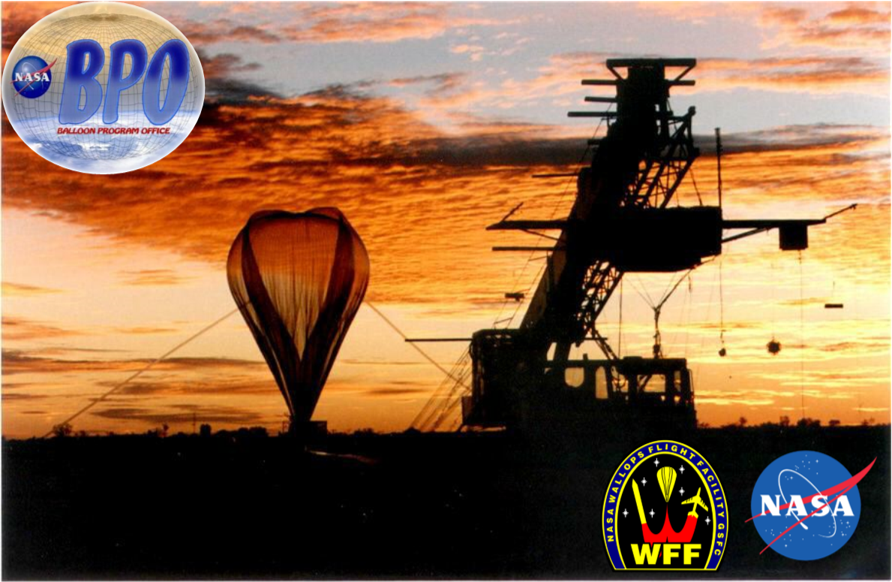
the Balloon Program Office of the National Aeronautics and Space Administration (NASA) is based at Wallops Flight Facility
Source: National Aeronautics and Space Administration (NASA), Scientific Balloons
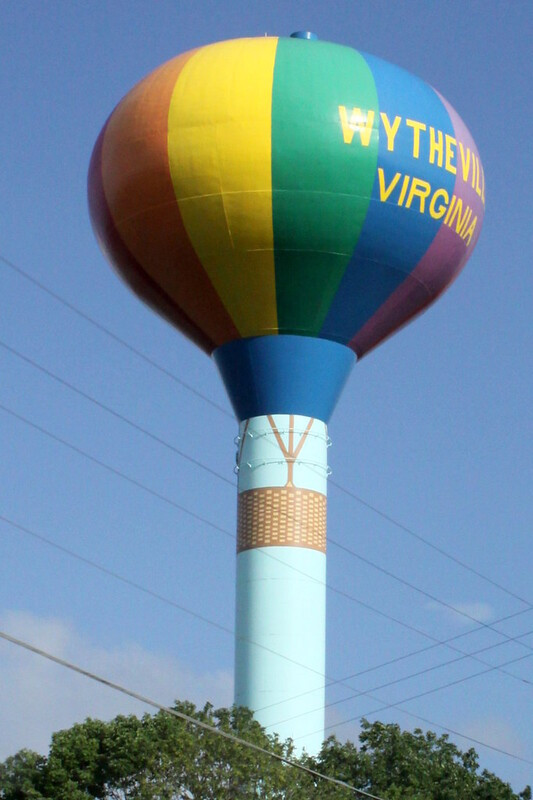
the water tower at Wytheville is painted to resemble a hot air balloon
Source: Flickr, Hot Air Balloon Water Tower - Wytheville, VA (by Brent Moore)
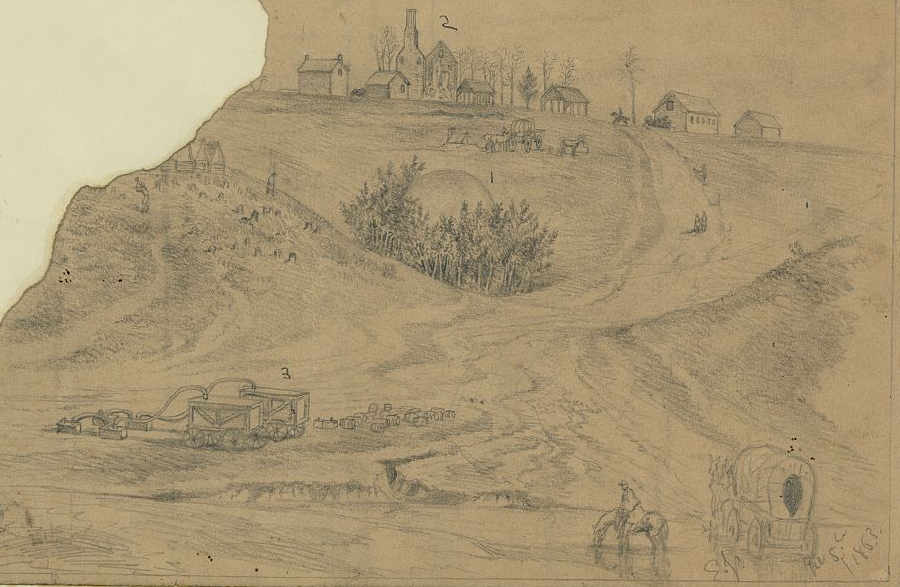
the Union Army used portable gas generators to inflate balloons
Source: Library of Congress, The army balloon at rest, (Prof. Lowe's) opposite Fredericksburg
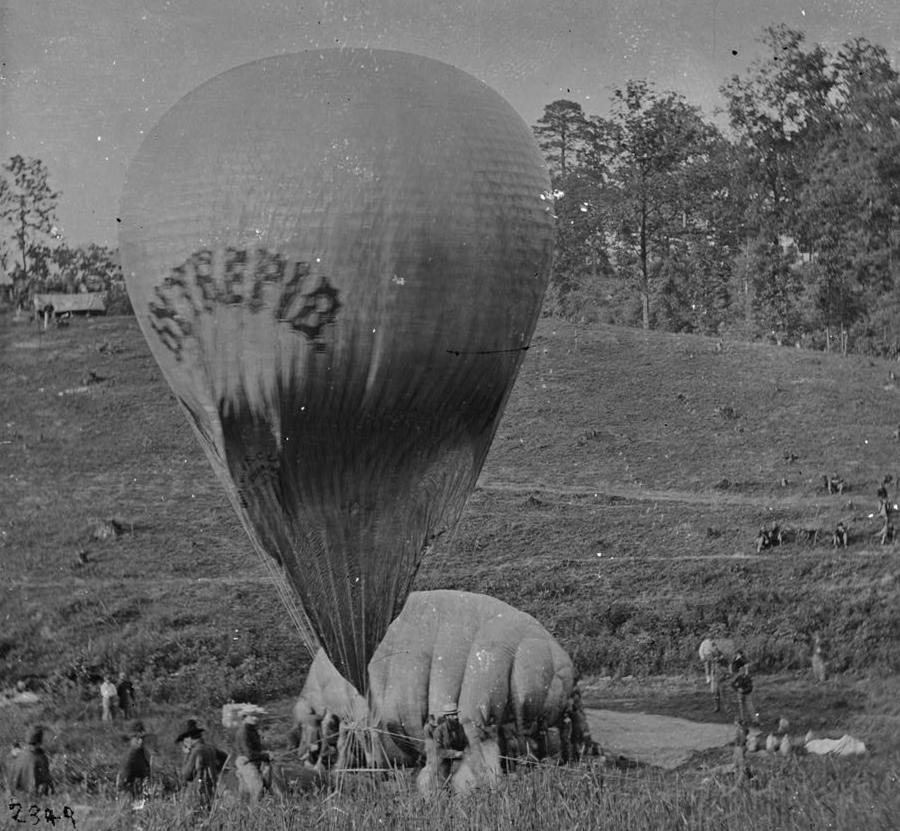
during the Civil War, gas was re-used wherever possible for a second balloon launch
Source: Library of Congress, Fair Oaks, Virginia. Prof. Thaddeus S. Lowe replenishing balloon INTREPID from balloon CONSTITUTION
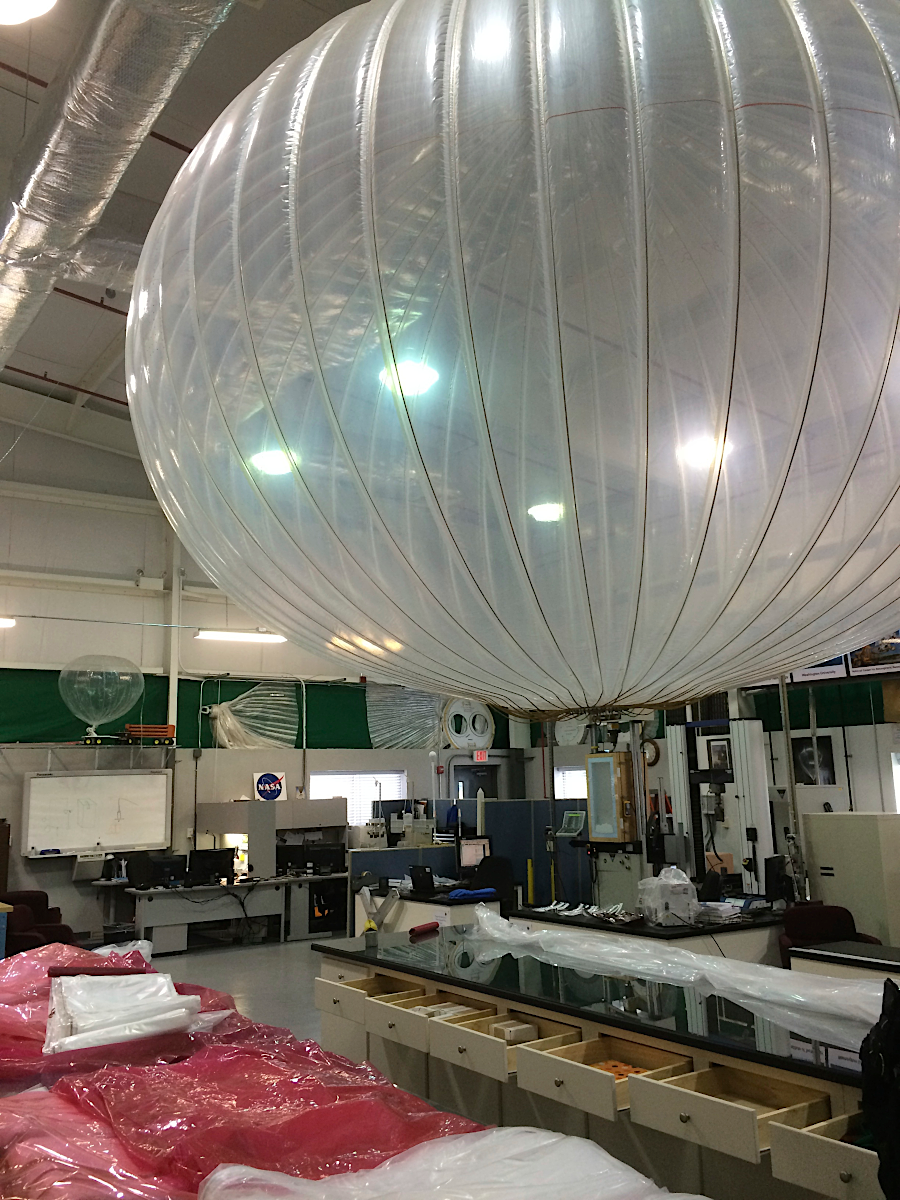
the National Aeronautics and Space Administration (NASA) uses balloons today to carry payloads to the edge of space, at lower cost than using rockets
Source: National Park Service, Balloon Science